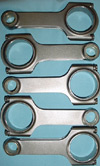Directional strength of steels
 There is little doubt that, in many ways, steels have improved markedly in recent years. Fatigue properties in particular have seen a large improvement owing to better steel cleanliness. However, it is not only the cleanliness that affects fatigue behaviour, but the processing of the steel, and this processing introduces anisotropy into the steel. Anisotropy is the effect whereby mechanical properties vary according to the direction in which they are measured.
There is little doubt that, in many ways, steels have improved markedly in recent years. Fatigue properties in particular have seen a large improvement owing to better steel cleanliness. However, it is not only the cleanliness that affects fatigue behaviour, but the processing of the steel, and this processing introduces anisotropy into the steel. Anisotropy is the effect whereby mechanical properties vary according to the direction in which they are measured.
By the use of directional processing, such as rolling or extrusion, any defects in the steel are elongated. Inclusions that would initially have been quasi-spherical are deformed such that they are very long compared to their width; we can understand this from the fact that the volume of the inclusion is not changed.
Let us assume that an inclusion is rolled such that it forms a long, wide defect, and that the piece of steel containing the defect is manufactured into a component where strength is critical, such as a con rod. If the 'long side' of the defect is aligned with the applied stress, then it presents little cross-sectional area, and its effect in terms of stress intensity factor means it is less likely to succumb to sudden failure from an overload. If the 'long side' of the defect, or largest cross-sectional area, is perpendicular to the applied stress then the tensile and fatigue strength of the material is much lower, and it is also more susceptible to the opening of an internal crack and failure from a single overload.
Fracture mechanics tells us that the product of fracture stress and the square root of flaw length is constant for a given material and type of loading. Therefore, by rolling an inclusion flat and loading the material in a direction perpendicular to the rolling direction, we lower the strength of the material.
This is why we have to be careful to align the material from which we make critical components carefully with the direction of stress, where significant anisotropy occurs. Many materials publications will give data for materials in both longitudinal and transverse directions.
Given that loading conditions are seldom simple enough to ensure loading parallel to the long side of inclusions, some companies have taken steps to minimise anisotropy. The main thrust of this work has been to reduce the general amount and size of any inclusions before any processing that would otherwise induce directional differences in mechanical properties.
Ovako has been instrumental in this using its IQ process*. This involves not only producing a steel with lower overall levels of 'problem' elements, such as sulphur, but also in the melting method and shielding of the molten material. This has helped eliminate all but the smallest (sub-20 micron) inclusions, and materials thus produced show improved fatigue properties. In producing materials with a smaller number of inclusions, and by taking measures to limit the size of such defects, gives an improved material after rolling, and there is much less difference in longitudinal and transverse properties.
Be very careful though when buying steels with an IQ reference. Some other general engineering steels have an IQ reference which has an altogether different meaning. So-called Inclusion Modified Steels marketed under the 'IQ' brand by some general steel stockholders aim to improve machining properties by adding extra quantities of elements that can and do cause real problems, as they can contain huge inclusions which, after rolling, run to many metres long in the bar. These render the material useless for highly stressed applications. One engine manufacturer had to scrap a large batch of cams due to such material being used, and I am sure many other components are compromised by the use of such steel.
*Ölund, P., "The IQ-process - the Ovako isotropic quality process", ISSN 0284-3366
Fig. 1 - Billet con rods need to be aligned to the rolled structure of the material to take advantage of the maximum strength of the material
Written by Wayne Ward